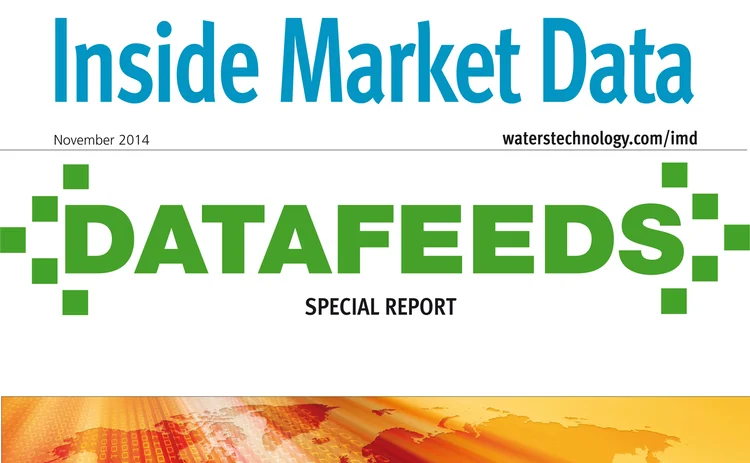Datafeeds Special Report

CLICK HERE TO DOWNLOAD THE FULL REPORT
Different Feeds for Different Folks
Over the past 15 years, the datafeeds landscape has changed beyond recognition. Once the preserve of only the largest firms with the most demanding requirements in terms of volume and performance, with most capital markets participants relying on terminals to meet their data requirements, the efficiency and speed advantages of both consolidated and direct feeds won over users at large and small firms alike.
On the direct feed side, this was largely driven by two factors: trading firms wanting faster and direct sources of data to support evolving algorithmic trading operations, and exchanges looking for new revenues, bypassing traditional consolidators with their own direct feed infrastructures. And despite these efforts, consolidated feed use has also grown as trading operations become more globalized and firms began demanding access to markets where direct feeds are either impractical or simply don't exist.
But if speed was the driving factor for feeds, the current focus is on flexibility and performance, where "performance" covers a multitude of factors beyond just speed, including reliability, capacity management and cost. So firms must not only invest in high-performance infrastructures to handle these datafeeds, but also in sophisticated monitoring systems to measure speed, uptime and other factors─though unlike in the past, when these were used by small business units running alongside enterprise systems, high performance is now the standard. "Speed has become an expectation, not a driver," says Adam Honore, chief executive of financial technology business strategy consultancy MarketsTech LLC.
However, over the same period, attrition and mergers have meant that the once-booming market for data distribution platforms and ticker plants has shrunk significantly, with much of this infrastructure business consolidating around a de facto incumbent, and only a few smaller technology companies providing competing platforms─though usually with limited capabilities.
Increased data availability has inevitably led to commoditization, and so in addition to datafeeds, firms are now looking at analytics that can deliver additional value and insight into the raw data. And with more analytics being presented via apps to serve the needs of an increasingly mobile workforce, new delivery mechanisms, APIs and cloud data marts are a logical next step for many data consumers─though participants in this report's Q&A say these will coexist with, rather than replace, the current generation of datafeed solutions.
Only users who have a paid subscription or are part of a corporate subscription are able to print or copy content.
To access these options, along with all other subscription benefits, please contact info@waterstechnology.com or view our subscription options here: http://subscriptions.waterstechnology.com/subscribe
You are currently unable to print this content. Please contact info@waterstechnology.com to find out more.
You are currently unable to copy this content. Please contact info@waterstechnology.com to find out more.
Copyright Infopro Digital Limited. All rights reserved.
As outlined in our terms and conditions, https://www.infopro-digital.com/terms-and-conditions/subscriptions/ (point 2.4), printing is limited to a single copy.
If you would like to purchase additional rights please email info@waterstechnology.com
Copyright Infopro Digital Limited. All rights reserved.
You may share this content using our article tools. As outlined in our terms and conditions, https://www.infopro-digital.com/terms-and-conditions/subscriptions/ (clause 2.4), an Authorised User may only make one copy of the materials for their own personal use. You must also comply with the restrictions in clause 2.5.
If you would like to purchase additional rights please email info@waterstechnology.com
More on Data Management
Tariffs, data spikes, and having a ‘reasonable level of paranoia’
History doesn’t repeat itself, but it rhymes. Covid brought a “new normal” and a multitude of lessons that markets—and people—are still learning. New tariffs and global economic uncertainty mean it’s time to apply them, ready or not.
HSBC’s former global head of market data to grow Expand Research consulting arm
The business will look to help pull together the company’s existing data optimization offerings.
Stocks are sinking again. Are traders better prepared this time?
The IMD Wrap: The economic indicators aren’t good. But almost two decades after the credit crunch and financial crisis, the data and tools that will allow us to spot potential catastrophes are more accurate and widely available.
In data expansion plans, TMX Datalinx eyes AI for private data
After buying Wall Street Horizon in 2022, the Canadian exchange group’s data arm is looking to apply a similar playbook to other niche data areas, starting with private assets.
Saugata Saha pilots S&P’s way through data interoperability, AI
Saha, who was named president of S&P Global Market Intelligence last year, details how the company is looking at enterprise data and the success of its early investments in AI.
Data partnerships, outsourced trading, developer wins, Studio Ghibli, and more
The Waters Cooler: CME and Google Cloud reach second base, Visible Alpha settles in at S&P, and another overnight trading venue is approved in this week’s news round-up.
A new data analytics studio born from a large asset manager hits the market
Amundi Asset Management’s tech arm is commercializing a tool that has 500 users at the buy-side firm.
One year on, S&P makes Visible Alpha more visible
The data giant says its acquisition of Visible Alpha last May is enabling it to bring the smaller vendor’s data to a range of new audiences.








